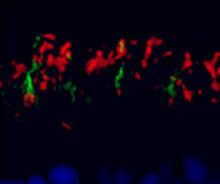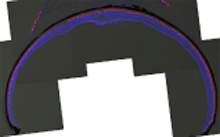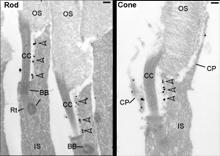Research
The research in the Yang laboratory is focused on the genetics of hereditary retinal degeneration, cell biology of photoreceptors and gene therapy. We use mouse models and a combination of approaches in molecular and cellular biology, biochemistry, electrophysiology, behavior, and various levels of microscopies.
Retinal degeneration is mainly caused by photoreceptor cell death and retinal pigment epithelium malfunction. It generally includes retinitis pigmentosa and macular degeneration. Although many genes have been identified as responsible for these diseases, their biological functions and the pathogenic mechanisms caused by their mutations are not clear. Additionally, many causative genes are still unidentified. Currently, no cure is available.
Disease mechanism of Usher syndrome: We investigate the biological functions of genes whose mutations are known to cause human retinal diseases, such as the three known genes involved in Usher syndrome type II, a disease with both vision and hearing loss. We have demonstrated that the encoded proteins of these genes, USH2A, VLGR1 and whirlin, form a multi-protein complex in both photoreceptors and hair cells. The normal localizations and protein amounts of these proteins are dependent on each other in vivo. In photoreceptors, this Usher II protein complex is located at the periciliary membrane complex at the base of the connecting cilium. However, the biological functions of both the Usher II protein complex and the periciliary membrane complex are completely unknown. The outer segment of photoreceptors, the essential cellular compartment for phototransduction, undergoes continuous and rapid renewal, which requires large-scale protein and membrane trafficking from the inner to the outer segment. The Usher II protein complex is currently proposed to be involved in this cellular event. We are now in the process to test this hypothesis.
Cell biology of photoreceptors: We are also interested in the cellular processes of intracellular trafficking, structural maintenance, and calcium regulation in photoreceptors. The current projects include 1) the biological functions of the ciliary rootlet, a cytoskeletal structure, in photoreceptors and how its defects cause retinal degeneration; 2) how calcium homeostasis is maintained in photoreceptor synaptic terminals and whether it is involved in retinal degeneration.
Gene therapy: We study therapeutic treatments for retinal degenerative diseases using mouse models. We have already successfully delivered whirlin into the photoreceptors of whirlin knockout mice via the AAV vectors. We observed correction of molecular defects in this mouse model. Now we continue to study the efficacy of this gene delivery system and how to solve the problem of delivering extremely long genes into the retina.







